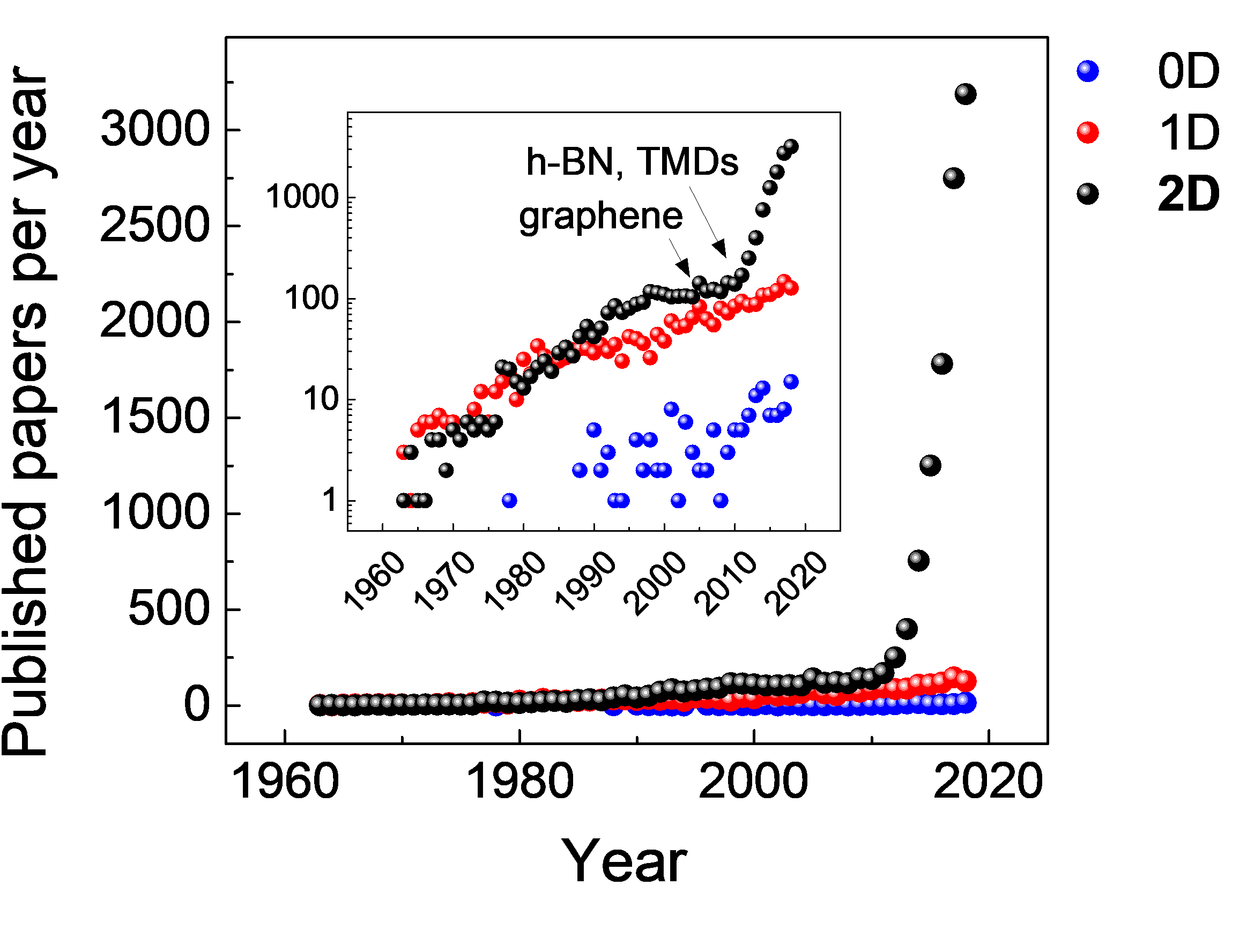2D Materials: From Structures to Functions
A special issue of Crystals (ISSN 2073-4352). This special issue belongs to the section "Inorganic Crystalline Materials".
Deadline for manuscript submissions: closed (30 September 2020) | Viewed by 21470
Special Issue Editors
Interests: thin film technology; chemical vapor deposition synthesis; synthetic diamond; self-assembled nanomaterials; layered double hydroxides; electrical and optical properties
Special Issues, Collections and Topics in MDPI journals
Interests: Molecular printing; 3D Printing; Dip Pen Nanolithography; Atomic Force Microscopy; Microfluidics; Nanowires; Fluorescence lifetime; nanomaterials/DNA/aptamer-based sensor; POC devices; DNA/aptamer; enzymes; biosensor design; medical applications; food and environmental applications
Special Issues, Collections and Topics in MDPI journals
Special Issue Information
Dear Colleagues,
Research in low-dimensional materials has been enjoying extraordinary growth in recent years, increasingly attracting the attention of a multidisciplinary scientific audience both for fundamental science and for technological applications. In particular, the current decade of the 2010s saw the boom of two-dimensional (2D) materials, triggered by pioneering works on graphene in 2004 and subsequent identification, at the beginning of 2010s, of other atomically thin monolayer systems, such as monolayer hexagonal boron nitride (h-BN) and transition metal dichalcogenides (TMDs). Since then, 2D materials and their combination in lateral and vertical heterostructures have been gaining an impressive research interest, accelerated by the availability of an increasingly broad portfolio of 2D candidate materials. The consequent result is the exponential growth in published papers per year, which passed from 139 in 2010 to 3189 in 2018 (see figure below). 2D materials are without doubt one of the most prolific areas of research in the last few years. Due to their thinness, enhanced surface effects, and unprecedented tunable confinement and geometry-related properties, 2D materials constitute a versatile platform for the realization of a new class of functional systems, opening up important applications in very different fields, namely, surface chemistry and (photo)catalysis, DNA nanostructures, biosensors, band–gap engineering, photovoltaics, electronics, photonics, energy storage, harvesting and conversion, nanomedicine, spintronics, and valleytronics. Moreover, van der Waals (vdW) heterostructures have recently emerged as an additional avenue to engineer new properties by stacking 2D compounds in a desired fashion.
|
|
Number of published research papers per year on zero-, one-, and two-dimensional (0D, 1D, 2D, respectively) materials. For each case, the displayed data are results of Scopus database searches for the eight keywords “**D [or **-dimensional] materials [or compounds, or semiconductors, or crystals]”, where ** = 0 (zero), 1 (one), 2 (two). Milestones in the literature of 2D materials, like the first papers on graphene and those on monolayers of hexagonal boron nitride (h-BN) and transition metal dichalcogenides (TMDs) are indicated in the inset, where results are reported in semi-logarithmic scale. From 2010 to the present, the number of publications per year on 2D materials jumped exponentially from 139 in 2010 to 3189 in 2018. |
Given the widespread contemporary interest in 2D materials, crystals, and compounds, the aim of this Special Issue is to provide an up-to-date international platform that can enable scientists from various disciplines to publish the latest advancements and up-to-date reviews on the following topics:
- Novel approaches for preparation of stable and large-scale 2D crystals: bottom–up direct synthesis methods (e.g., chemical vapor deposition, wet–chemical methods, topochemical synthesis), and top–down exfoliation routes (e.g., micromechanical, ultrasonic, ion-exchange exfoliation);
- New efforts put forward to expand the portfolio of 2D materials to search from for optimal properties, encouraging both high-throughput computational methods and experimental research for synthesis of new 2D crystals;
- Lateral and vertical 2D material heterostructures: characterization, fabrication, and study of related devices;
- Characterization techniques of 2D materials: electronic, optical, mechanical properties, morphological analysis (e.g., SEM, TEM), crystallographic studies, and AFM measurements. Particular attention should be given to the study of crystal properties, and to investigating the influence of measurement conditions (e.g., moisture, ambient gas/2D surface interaction, supporting substrate) on the results from characterization techniques;
- Novel applications of 2D materials in pharmacy, biology, medicine, and green chemistry;
- Light–matter interactions in 2D materials, through excitons and polarons;
- Chemical functionalization of 2D materials;
- Ion beam modifications of 2D materials, plasma induced changes to 2D systems, defect engineering;
- Integration of 2D materials with conventional semiconductors for electronics and optoelectronics;
- Theory and modelling of 2D materials and related devices.
Dr. Giuseppe Prestopino
Dr. Giuseppe Arrabito
Guest Editors
Manuscript Submission Information
Manuscripts should be submitted online at www.mdpi.com by registering and logging in to this website. Once you are registered, click here to go to the submission form. Manuscripts can be submitted until the deadline. All submissions that pass pre-check are peer-reviewed. Accepted papers will be published continuously in the journal (as soon as accepted) and will be listed together on the special issue website. Research articles, review articles as well as short communications are invited. For planned papers, a title and short abstract (about 100 words) can be sent to the Editorial Office for announcement on this website.
Submitted manuscripts should not have been published previously, nor be under consideration for publication elsewhere (except conference proceedings papers). All manuscripts are thoroughly refereed through a single-blind peer-review process. A guide for authors and other relevant information for submission of manuscripts is available on the Instructions for Authors page. Crystals is an international peer-reviewed open access monthly journal published by MDPI.
Please visit the Instructions for Authors page before submitting a manuscript. The Article Processing Charge (APC) for publication in this open access journal is 2600 CHF (Swiss Francs). Submitted papers should be well formatted and use good English. Authors may use MDPI's English editing service prior to publication or during author revisions.
Keywords
- Green chemistry
- Surface chemistry
- Growth of 2D crystals: bottom–up and top–down strategies
- Characterization techniques: electronic transport, optical, and mechanical properties
- Exfoliation of parent layered compounds
- Nanoscale engineering
- van der Waals 2D materials
- 2D materials
- Lateral heterostructures
- Vertical heterostructures
- Quantum confinement
- Photophysics of 2D compounds







